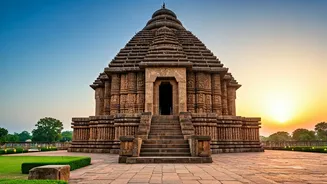Konark Sun Temple
The Konark Sun Temple in Odisha stands as a testament to the Kalinga dynasty's architectural prowess, built in the 13th century. Designed as a colossal
chariot of the Sun God, Surya, it features intricately carved wheels, horses, and sculptures. Its unique design and elaborate details, including depictions of daily life and mythological scenes, make it a UNESCO World Heritage site and a prominent example of ancient Indian craftsmanship. The temple's grandeur symbolizes the sun's power and divinity, drawing devotees and tourists alike to witness its magnificence and spiritual aura.
Modhera Sun Temple
Located in Gujarat, the Modhera Sun Temple, erected in the 11th century by the Solanki dynasty, is a masterpiece of Indian architecture. The temple's design incorporates a stepped tank, a sabha mandapa (assembly hall), and a main shrine, all adorned with intricate carvings depicting various deities, celestial beings, and scenes from the Ramayana and Mahabharata. The temple's alignment with the sun's path during the equinoxes and solstices highlights the ancient architects' astronomical knowledge. The site's serene atmosphere and the artistic detailing contribute to its status as a significant cultural and historical destination.
Martand Sun Temple
The Martand Sun Temple, situated in Kashmir, was built by the Karkota dynasty during the 8th century. Though now in ruins, its remnants still showcase the temple's former grandeur. The structure's design includes a central shrine surrounded by a courtyard with colonnades, displaying a blend of Indian and Greco-Roman architectural styles. The temple was once a significant religious center, and its ruins stand as a symbol of the region's rich historical and cultural legacy, offering insight into the kingdom's past and artistic prowess, making it a landmark for heritage enthusiasts.
Sun Temple, Deo
The Sun Temple at Deo, found in Bihar, is a lesser-known but equally significant site. The temple's structure dates back to the 7th century, representing a unique architectural style. Made with black stone, it is known for its detailed carvings and the annual Chhath Puja celebrations. The temple is an important site for devotees and visitors interested in local traditions, offering a look at ancient craftsmanship and regional religious practices. Its peaceful environment and historical relevance make it a valuable destination for cultural exploration.
Surya Pahar, Assam
Surya Pahar in Assam is an archeological site featuring several ancient temples and rock-cut sculptures dedicated to the Sun God. The site's significance includes the presence of various architectural remains, signifying its importance as a religious center. The scattered temples and carvings reveal the site's rich historical and religious background. The serene atmosphere and the natural setting of Surya Pahar contribute to its attraction as a peaceful destination, providing an opportunity for historical reflection and exploration of ancient religious practices.















